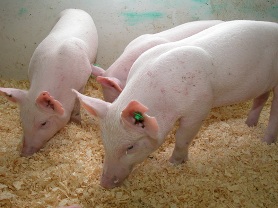Phytate digesting pig up for approval

The Enviropig is now up for approval by Canadian and US safety agencies after more than a decade of development, but hog industry experts are still lukewarm at best about the creature.
“It’s an excellent concept, but I can’t even speculate on when it might even possibly be incorporated, if it ever will be, because there are so many other issues,” said Laurie Connor, the head of animal science at the University of Manitoba.
<–The Enviropig looks just a regular pig, but its manure is significantly easier on the environment, according to its creators. (Photo: Dr. Cecil Forsberg / University of Guelph)
Enviropig is a genetically engineered pig that expels lower amounts of phosphorus than traditional pigs. “There’s not a big push within the industry to embrace that particular direction.”
Mice genes included
Enviropig is a genetically engineered line of Yorkshire pigs developed at Ontario’s University of Guelph. The pigs have the ability to digest plant phosphorus more efficiently than conventional Yorkshire pigs.
Researchers found a way to splice genes from mice and E. coli bacteria into the genetic structure of pigs to allow animals to digest a higher proportion of the phosphorus in their feed.
Benefits of the Enviropig:
- The pigs produce an enzyme called phytase in their salivary glands that helps their stomachs break down indigestible phytate in their feed. Phytate accounts for 50 to 75 percent of grain phosphorus.
- The Enviropig’s ability to better use grain phosphorus eliminates the need to supplement with mineral phosphate or commercially produced phytase.
- There is also less phosphorus in the animal’s manure.
- When phosphorus-depleted manure is spread on land in areas of intense swine production, there is less potential of phosphorus to leach into freshwater ponds, streams and rivers, reducing algae growth and limiting adverse effects on water quality.
Anxiety among industry
Many people in hog production are downright frightened by the concept, which they think could produce something that enemies of hog producers would love to exploit.
The anxiety and qualified support have followed the Enviropig since it was created in the late 1990s at the University of Guelph in southern Ontario.
On Feb. 20, Environment Canada announced that Guelph had received its approval to produce Enviropigs using “approved containment procedures,” according to the university.
The Enviropig was not found to represent dangers to the environment and will continue to be bred. In 2002, the university caused a squall of controversy when it sent Enviropig carcasses into the animal feed system but after that, tougher segregation safeguards were put into place.
Connor said reducing phosphorus output from pigs is a key industry concern, but genetic modification is not the only answer. Already supplements like phytase and research into balanced feed rations are allowing producers to increase phosphorus digestion and limit phosphorus extrusion.
Long way to go
And she said the Enviropig is probably a long way from getting into the commercial herd because not only will it need to be approved by health authorities and markets around the world, but it will also need to catch up with the breeding industry.
“Producing a high efficiency and high meat quality animal are things of paramount importance that have to go along with environmental sustainability and environmental responsibility,” said Connor.
The genetic basis of the Enviropigs may be well behind modern production animals now, she said.











